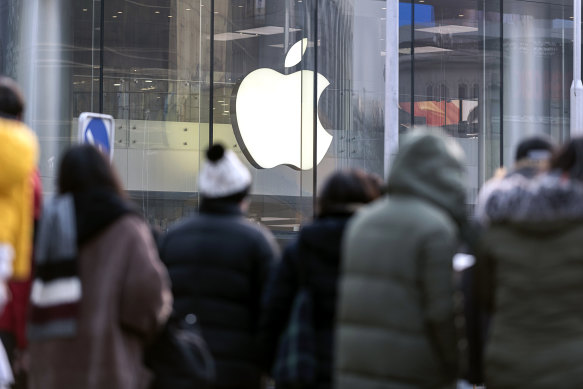- Analysis
- Technology
- Apps
‘End of the world’: The Apple change that has flown under the radar
By Kevin Roose
This year, when Apple announced iOS 18, the latest version of its mobile operating system, most of the attention went to its slate of new artificial intelligence features.
But a lesser-noticed change in iOS 18 — a tweak to an obscure feature that allows users to share their contact lists with various apps — may wind up being more important.

The drama demonstrates how powerful gatekeepers like Apple have become and how even minor changes to Apple’s products can create dramatic ripple effects in the rest of the tech industry.Credit: Bloomberg
That’s because “contact sync,” as the feature is known by some developers, has played a critical role in the growth of many social and messaging apps for the past two decades. It’s how apps like Instagram, WhatsApp and Snapchat were able to find their footing, by quickly connecting millions of iPhone users to people they already knew, and suggesting other users for them to follow. That early momentum helped kick-start their viral growth, propelling them to the top of the App Store charts.
Now, some developers are worried that they may struggle to get new apps off the ground. Nikita Bier, a startup founder and adviser who has created and sold several viral apps aimed at young people, has called the iOS 18 changes “the end of the world,” and said they could render new friend-based social apps “dead on arrival.”
That might be a little melodramatic. I recently spent some time talking to Bier and other app developers and digging into the changes. I also heard from Apple about why it believes the changes are good for users’ privacy, and from some of Apple’s rivals, which see it as an underhanded move intended to hurt competitors. And I came away with mixed feelings.
On one hand, I’m sympathetic to the uphill battle faced by any developer trying to build a new social app today. The contact sharing changes in iOS 18 will undoubtedly make it harder for some fledgling apps to break through. And in a world where it’s harder for smaller apps to succeed, incumbents like Facebook and Instagram — which already have network effects, and don’t have to ask existing users for permission to keep collecting their contacts — obviously stand to benefit.
But I’m also sympathetic to Apple’s stance that giving users more control over which contacts they share is a good thing for privacy, and that apps that ask users to hand over their entire contact lists can be creepy and invasive. (Personally, I plan on using this feature to avoid sharing sensitive contacts, such as confidential sources, with the dozens of social and messaging apps I use.)
Mostly, the drama demonstrates how powerful gatekeepers like Apple have become and how even minor changes to Apple’s products can create dramatic ripple effects in the rest of the tech industry. It also illustrates the trade-offs that many tech companies and regulators are grappling with, as they try to promote competition while also protecting privacy.
For years now, the way contact sharing has worked on iOS devices is that an app can trigger a message called a “data access prompt,” asking for access to a user’s contacts.
If the user agreed, the app developer got a list of all the contacts in that user’s address book, along with other information stored in the user’s contact cards, such as phone numbers and email addresses. App developers could then use that information to build out a user’s social graph, or suggest other accounts for the user to follow.
In iOS 18, however, users who agree to give an app access to their contacts are shown a second message, allowing them to select which contacts to share. Users can opt to share just a handful of contacts by selecting them one by one, rather than forking over their entire address book.

The sync contacts function allowed friend-based apps like Instagram, WhatsApp and Snapchat to quickly connect millions of iPhone users to people they already knew, while suggesting other users for them to follow.Credit: iStock
Apple’s stated rationale for these changes is simple: Users shouldn’t be forced to make an all-or-nothing choice. Many users have hundreds or thousands of contacts on their iPhones, including some they’d rather not share. (A therapist, an ex, a random person they met in a bar in 2013.) iOS has allowed users to give apps selective access to their photos for years; shouldn’t the same principle apply to their contacts?
Apple also made it clear that it didn’t think the iOS 18 changes would hurt app developers. In fact, the company told me, developers might see an uptick in contact sharing, if users who previously would have declined to share any contacts can just share the ones they want.
App developers think that’s a bogus argument. Bier told me that data he had seen from startups he advised suggested that contact sharing had dropped significantly since the iOS 18 changes went into effect, and that for some apps, the number of users sharing 10 or fewer contacts had increased as much as 25 per cent. (Other developers said their own apps had experienced similar declines, though nobody except Bier would agree to speak on the record, out of fear of angering the Cupertino colossus.)
A 25 per cent decline in contact sharing might not sound like a huge change. But for social apps, the ability to quickly connect new users with their friends can mean the difference between success and failure. Facebook, for example, discovered during its early days that if users added seven friends within 10 days of signing up for an account, they were more likely to stick around than users who didn’t.
“It’s critical to form density on an early-stage app,” Bier said. “People don’t wait around for a week for all their friends to sign up.”
Some developers also pointed out that the iOS 18 changes don’t apply to Apple’s own services. For example, iMessage doesn’t have to ask for permission for access to users’ contacts the way WhatsApp, Signal, WeChat and other third-party messaging apps do. They see that as fundamentally anticompetitive — a clear-cut example of the kind of self-preferencing that antitrust regulators have objected to in other contexts.
Of course, iPhone users can still upload their whole address books if they choose. (There’s also Android, which still requires users to make an all-or-nothing choice.) But it’s reasonable to assume that the added friction of a second screen will result in fewer contacts being shared.
The result, Bier said, might be that friend-based social apps will simply be replaced by apps like TikTok, which show users content based on what they like rather than whom they’re connected to, or AI companionship apps that don’t require humans at all.
“You’d have to be pretty crazy already to do a friend-based social app,” he said. “Now, it’s all but impossible.”
This article originally appeared in The New York Times.
Get news and reviews on technology, gadgets and gaming in our Technology newsletter every Friday. Sign up here.